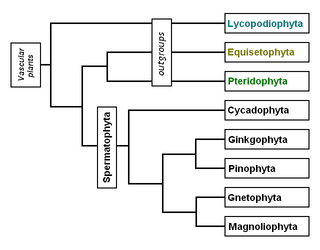Spermatophyte
|
|
The spermatophytes comprise those plants that produce seeds. They are included in the embryophytes or land plants, which also includes various groups that reproduce by spores, such as mosses, liverworts, hornworts, and ferns.
Seed-bearing plants were traditionally divided into angiosperms, or flowering plants, and gymnosperms, which includes the gnetae, cycads, ginkgo, and conifers. Angiosperms are now thought to have evolved from a gymnosperm ancestor, which would make the gymnosperm taxon paraphyletic. Modern cladistics attempts to define taxa that are monophyletic, traceable to a common ancestor and inclusive therefore of all descendants of that common ancestor. Although not a monophyletic taxon, gymnosperm is still widely used to distinguish the four taxa of non-flowering, seed-bearing plants from the angiosperms.
A traditional classification grouped all the seed plants together as follows:
- Division Spermatophyta
- Cycadopsida, the cycads
- Ginkgoopsida, the ginkgo
- Pinopsida, the conifers, ("Coniferopsida")
- Gnetopsida, including Gnetum, Welwitschia, Ephedra
- Magnoliopsida, the flowering plants, or Angiospermopsida
In addition to the taxa listed above, the fossil record contains evidence of many extinct taxa of seed plants. The so-called "seed ferns" (Pteridospermae) were one of the earliest successful groups of land plants, and forests dominated by seed ferns were prevalent in the late Paleozoic. Glossopteris was the most prominent tree genus in the ancient southern supercontinent of Gondwana during the Permian period. By the Triassic period, seed ferns had declined in importance, and gymnosperms were predominant until the Cretaceous, when the Angiosperms became predominant.
A more modern classification splits these groups into separate divisions (sometimes under the Superdivision Spermatophyta):
- Cycadophyta, the cycads
- Ginkgophyta, the ginkgo
- Pinophyta, the conifers
- Gnetophyta, including Gnetum, Welwitschia, Ephedra
- Magnoliophyta, the flowering plants

